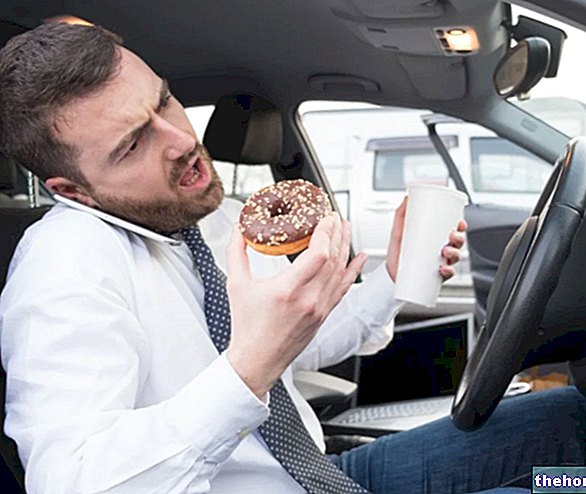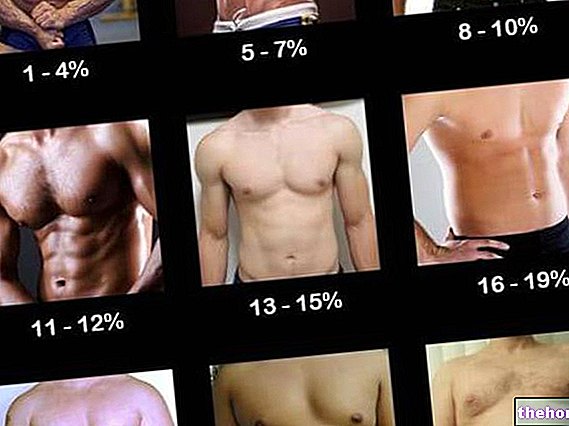Edited by Dr. Stefano Casali
The total daily energy expenditure is given by the sum of:
- Basal metabolism (60-70%)
- Physical activity induced thermogenesis (20-30%)
- Diet-induced thermogenesis (10%)
Basal metabolism
Represents the energy expenditure at complete physical and psycho-sensorial rest:
- Patient lying down
- Awake for about half an hour after a restful sleep of at least 8 hours
- In a thermoneutral state (22 ° -26 °)
- 12-14 hours from "taking" the last meal
- Soft lights and absence of auditory stimuli
Physical activity induced thermogenesis
It represents the energy expenditure necessary to perform any type of physical activity; it is determined by the type, duration and intensity of the work performed.
Diet-induced thermogenesis
It stands out in
- Mandatory (60-70%): necessary for the processes of digestion, absorption, transport and assimilation of ingested food;
- Optional (30-40%): stimulation of the sympathetic by the ingestion of carbohydrates and nerve foods

LARN: Recommended daily intake levels of energy and nutrients
Energy requirements
(kcal / day)
Proteins
(g / day)
Lipids
(g / day)
Carbohydrates
(g / day)
Males
(18-29 years old)
2543
65
72
421
Females
(18-29 years old)
2043
51
57
332
Average of the basal metabolic rate of Italian men and women
Men
Women
Average
Range
Average
Range
7983 kJ / 24h
1900 kcal / 24h
6320 to 12502
from 1500 to 2976
6127 kJ / 24h
1458 Kcal / 24h
3465 to 8744
825 to 2081
De Lorenzo et al. Measured and predicted resting metabolic rate in Italians males and females, aged 18-59 y European Journal Clinical Nutrition 55: 1-7; 2001
Techniques for measuring energy expenditure
- Direct calorimetry
- Indirect calorimetry
Direct calorimetry
It is performed by placing the subject inside a calorimetric chamber, thermally insulated, so as to be able to evaluate the heat that he emanates by radiation, convection, conduction and evaporation; this heat is detected by a water-cooled heat exchanger.
Indirect calorimetry
It allows the evaluation of energy expenditure through the measurement of O2 consumption and CO2 production.
Lipids
Carbohydrates
Proteins
Biological caloric value
9 kcal / g
4 kcl / g
4 kcal / g
QR (respiratory quotient)
0,710
1,000
0,835
Caloric equivalent of O2
4.683
5.044
4.650
Coefficient of digestibility (CD)
Amount of food actually digested and absorbed compared to that taken with the diet:
- Average carbohydrate CD 97%
- Mean lipid CD 95%
- Mean protein CD 92%
Respiratory quotient
QR of carbohydrates
C6 H12 O6 + 6 O2 → 6 CO2 + 6 H2O
QR = 6 CO2 / 6 O2 = 1
QR of lipids
C16 H32 O6 + 23 O2 → 16 CO2 + 16 H2O
QR = 16 CO2 / 23 O2 = 0.696
QR of proteins
Albumin → C72 H112 N2 O2 2S + 77O2
Urea → 63 CO2 + 38 H2O + SO3 + 9CO (NH2) 2
QR = 63 CO2 / 77 O2 = 0.818
Factors affecting the QR
- Diabetes and prolonged fasting
- Intense and short muscle work
- Muscle work recovery phase
- Hyper- and hypo-ventilation
Maximum oxygen consumption (VO2 max)
When oxygen consumption no longer increases in response to an increase in energy demand, maximum oxygen consumption is said to have been reached.
To understand what the maximum oxygen consumption is, consider a person who starts running. If he starts from a condition of rest, energy mechanisms are set in motion faster than the aerobic ones (ie those that use oxygen) to compensate for the "Initial lack of energy, given the slowness of the aerobic mechanisms. ATP-CP (creatine phosphates) and glycolysis mechanisms (ie carbohydrates burned without the use of oxygen) are used; after a few minutes (from two to four depending on the training of the subject) the aerobic mechanisms have adapted to the energy demand and the state of equilibrium begins. During this state the athlete consumes oxygen and this consumption is constant. If the effort increases (as can be seen by running the subject on a treadmill with increasing inclinations of the incline) the consumption of oxygen also increases. At some point the aerobic mechanism will not be able to supply the required energy and will begin the production of lactic acid. The athlete's oxygen consumption will still increase, however, until the increase in energy demand no longer increases: the athlete has reached maximum oxygen consumption (VO2max). It is verified that the "athlete is able to prolong the effort in conditions of VO2max for about 7" and that the situation corresponds to blood lactate concentrations ranging from 5 to 8 mmol (conventionally 6.5).
In more practical terms:
the maximum oxygen consumption corresponds to the maximum aerobic power.
Bibliography
Brooks G.A. Lactate production during exercise: oxidizable subtrate versus fatigue agent. In Exercise: benefits, limits and adaptations pp 144- 158 London.
Fox Bower Foss The basics of physical education and sport. Scientific thought publisher.
Cerretelli P. Manual of physiology of sport and muscular work. Universe Publishing Company.
Bobis. Metabolic aspects of fatigue during sprinting. In Exercise: benefits, limits and adaptations.
Brandi LS. Indirect calorimetry and critical illness: principles and clinical applications. In Gentile MG, ed. Updates in Clinical Nutrition 7. Rome: Il Pensiero Scientifico Editore 1999.
Greco AV, Mingone G. Tatarrani PA., Et al. Determination of energy expenditure. Quon 1994.
Greco AV., Mingone G., Indirect calorimetry in the study of energy expenditure. In: Borsello O., and Multidimensional Treated Obesity. Milan: Kurtis Publishing 1998.
Caviziel F., Croci M., Greco M., The predictive equations of energy expenditure: utility and limits. Quon 1995.
Fundamentals of Human Nutrition, The Scientific Thought Publisher, Aldo Mariani Costantini, Carlo Cannella, Giovanni Tomassi.




























